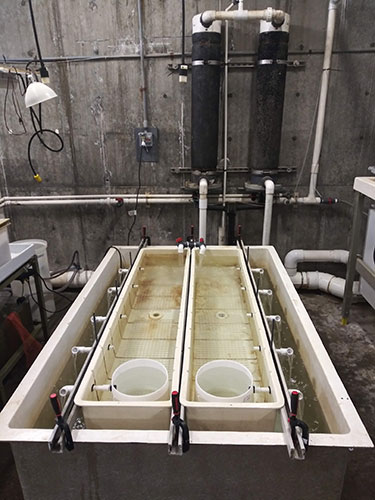The Bodega Marine Laboratory was founded in 1960 by UC Berkeley and acquired by UC Davis in 1983. It is a multidisciplinary research institution capable of hosting visiting aquaculture researchers year round. Numerous indoor and outdoor aquaculture facilities are utilized for crustacean, molluscan and fishery aquaculture, as well as barren urchin ranching and sterile algal culture. Abalone and native oyster aquaculture are current focal points.
 In collaboration with industry partners, BML develops standard operating procedures for native and non-native oyster culture, producing “spat” for commercial and restorative out-planting of underutilized oyster species. The abalone aquaculture project includes efforts to save an endangered species.
In collaboration with industry partners, BML develops standard operating procedures for native and non-native oyster culture, producing “spat” for commercial and restorative out-planting of underutilized oyster species. The abalone aquaculture project includes efforts to save an endangered species.
In coordination with NOAA Fisheries, California Sea Grant and the California Department of Fish and Wildlife, BML houses an abalone captive breeding program. The White Abalone Restoration Consortium (WARC), consisting of 10 agencies, collaborate to spawn and raise captive bred abalone for out-planting. Culturing viable abalone larvae requires year-round brood stock conditioning, feeding, induced spawning, and rearing of juvenile abalone. The successful white abalone captive breeding program increased larval production from dozens of white abalone in 2012 to thousands in 2014. The first out-planting of 3,200 captive bred white abalone occurred during November 2019 in southern California.
Aquaculture Facility History and Services
- Fully functional bivalve hatchery and larval rearing services
- Downweller systems for spat settlement services
- Upweller systems for spat grow out systems and services
- Sterile algae culture facilities and services
In the mid 1990’s BML aquaculture staff began working in support of BML’s novel experimental shellfish hatchery. This hatchery was developed for Dr. Dennis Hedgecock who was studying Genetics and hybrid vigor in pacific oysters. Algae culture techniques and facilities were also developed at this time.
- 2002 - The ARG team began developing techniques to culture and settle native oysters. Native oysters were successfully settled on various substrates at specified densities. Graduate researchers working under professors at BML used the settled oysters for research on predation and ocean acidification. The early success of these oyster hatchery techniques has led to continued, on-going research.
- 2009 - ARG began working with Sea Grant to culture experimental lines of pacific oysters for the shellfish industry. This was a first step into current industry partnerships.
- 2013 - During Sea Grant Scallop aquaculture research (with Paul Olin), ARG worked to develop techniques for diploid rock scallop culture using local wild broodstock as well as broodstock supplied by industry partners. Diploid culture was successful based on serotonin induced gamete collection and successful fertilization. Diploid seed quantities were limited, but long term seed survival was very good.
- 2017-Present - Over the past 5 years, ARG has developed new oyster hatchery practices and protocols with various oyster species. Early success with seed production and outplant survivorship has led to ongoing partnerships.

